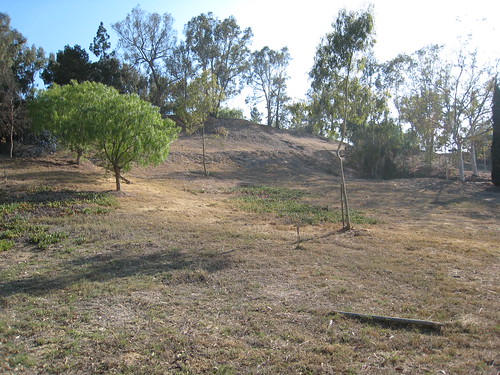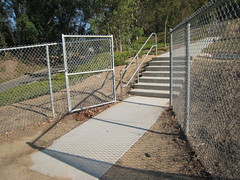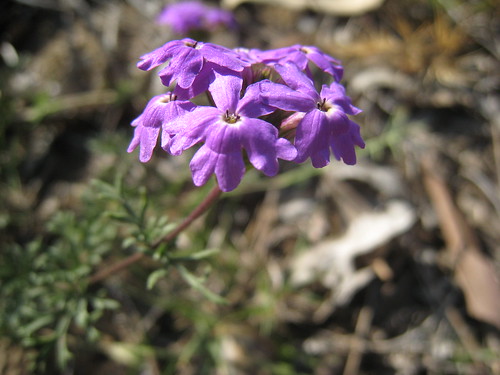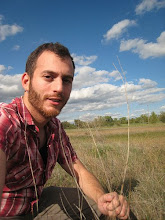CommunityWalk Map - San Gabriel River ParkwayThe San Gabriel River Parkway and Monteverde Park in Lakewood are, perhaps, better examples of landscaping with native vegetation than native habitat restoration. The Parkway has a very manicured appearance, with long stretches of grass intersperesed with native plant gardens. Perhaps this appearance is a result of the newness of the park. The older portions at the southern end of the Parkway have larger patches of sage-scrub, more similar in appearance to the Long Beach Greenbelt.
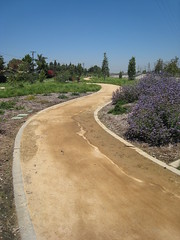
None of this means that the Parkway isn't a beautiful place to visit, or that it lacks the wildlife benefits of more wild parks. The bird-life here is terrific, as flocks of finches and mourning doves gorge themselves on seeds, phoebes catch insects mid-air, and scrub jays squawk aggressively to establish their territories. I believe that the the River Parkway is an excellent example of how environmental concerns can be accomodated in even non-wildland parks, and I hope that this approach gets more widespread.
There are two parts to the parkway: Phase I (the larger, southern portion, between Carson Street and Del Amo Boulevard) and Phase II (the smaller northern portion, just above Del Amo). In between is Monteverde Park, which is partially landscaped by native plants and attepmts to recreate a few natural communities.

The trail winds sinuously through the parkway from one garden-like planting to the next. There is little shade in the park, as most of the trees are still very short. Perhaps in a few years, this park will be a bit more shady.
Trees of the Parkway:
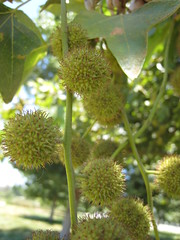 Western sycamore (Platanus racemosa) is a typical riparian tree, growing along-side streams and in moist canyons. It has distinctive mottled bark, and the fruits hang in little strings.
Western sycamore (Platanus racemosa) is a typical riparian tree, growing along-side streams and in moist canyons. It has distinctive mottled bark, and the fruits hang in little strings.
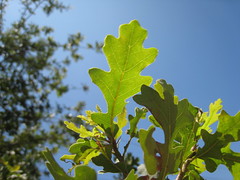
Valley oaks (Quercus lobata) grow well in moist areas. Old trees can reach impressive stature. The tree drops its broad, thin leaves in the winter. Poor regeneration has been documented throughout the state, and this oak is now increasingly threatened.

The coast live oak (Quercus agrifolia) is far more common in our region than the valley oak. It keeps its hard brittle leaves throughout the year.
The beds are lushly planted with wildflowers typical of coastal sage-scrub, such as California sage, buckwheat, and Mexican elderberry. Maby of these plants have showy flowers and are very attractive to butterflies. The berries and seeds are also important food for wildlife.
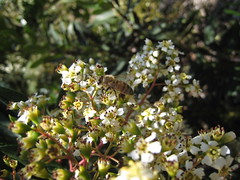 Honey bee (Apis mellifera) visiting the flowers of a Mexican elderberry (Sambucus mexicana)
Honey bee (Apis mellifera) visiting the flowers of a Mexican elderberry (Sambucus mexicana)
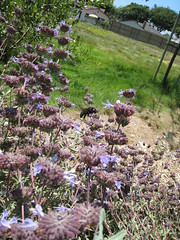
A huge carpenter bee (Xylocarpa sp.) visits the flowers of Cleveland sage (Salvia clevelandii)
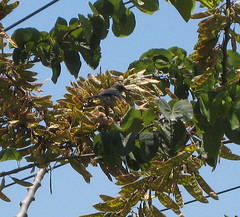
A scrub-jay (Aphelocoma californica) in a western redbud tree (Cercis occidentalis)
There are plenty of wildflowers to enjoy here:
 Cleveland sage (Salvia clevelandii)
Cleveland sage (Salvia clevelandii)
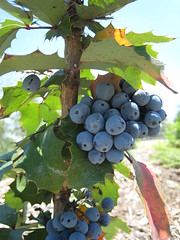
Creeping majonia (Berberis aquifolium repens)
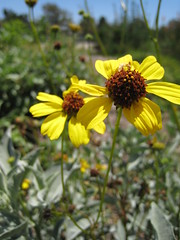
Bush sunflower (Encelia californica)
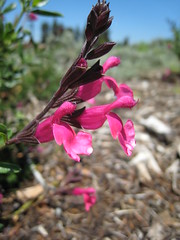
[Need ID]
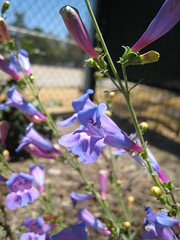
[Need ID]
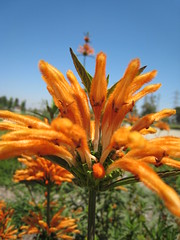
[Need ID]
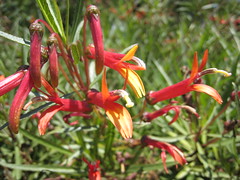
[Need ID]Among the plantings are nonnative butterfly bushes (
Buddleja davidii). This plant was an unfortunate choice to include in the park, as
Buddleja is a major invasive pest and a threat to native plants.


Outside the gardens, the grass grows a bit wild, and many wildflowers proliferate here.
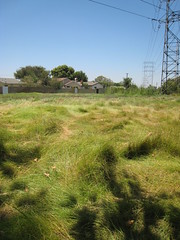 The unmowed grass reflects a wildlife-friendly and water-wise approach to park management.
The unmowed grass reflects a wildlife-friendly and water-wise approach to park management.
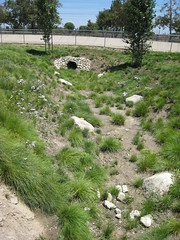
The landscape is countoured to direct the flow to the river. The vegetation in the swale provides some treatment for the stormwater. In these wetter areas, the wildflowers are most abundant.
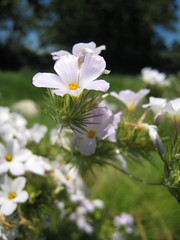
Flax-flowered linanthus (Linanthus liniflorus) is one of the more common and shower flowers in this area.
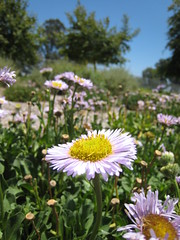
An aster (probably Erigeron sp.)

Yarrow, or milfoil (Achillea millefolium) has strongly aromatic leaves.
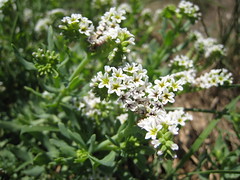
Heliotrope (Heliotropium curassavicum)In very wet areas of the grass, stands of cattails grow.
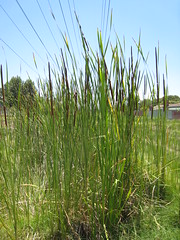
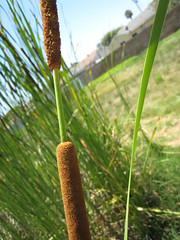 Southern cattail (Typha domingensis) is distinguished from other species by the wide space between the upper male flowers and the lower female flowers.
Southern cattail (Typha domingensis) is distinguished from other species by the wide space between the upper male flowers and the lower female flowers.
At the southern end of the parkway, the more mature plantings take on a more genuinely wild appearance, like a natural sage-scrub habitat. These areas are profuse with flowering sages, buckwheat, and sagebrush.
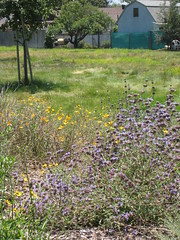 The orange poppies (Eschscholzii californica)and the purple Cleveland sage flowers (Salvia clevelandii) make an excellent contrast!
The orange poppies (Eschscholzii californica)and the purple Cleveland sage flowers (Salvia clevelandii) make an excellent contrast!
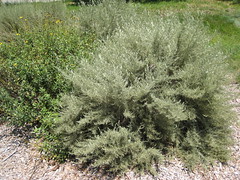
The silvery gray California sagebrush (Artemesia californica) is one of the most important plants of the coastal sage-scrub. Many species of birds rely on its leaves for cover and its seeds for food. The yellow flowers behind belong to the bush sunflower (Encelia californica).
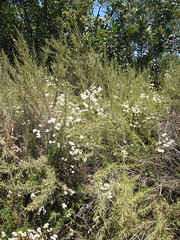
California buckwheat (Eriogonum fasciculatum) provides white-to-pink flowers all year.

A large expanse of sage provides a striking note for its foliage as much as for its flowers.In addition to coastal sage-scrub, the southern end of the parkway has a few chaparral areas as well. Many, like the California lilac, have conspiculous flowers.
 California lilac (Ceanothus sp.)
California lilac (Ceanothus sp.)

Manzanita (Arctostaphylos sp.). The bright red leaves are galls caused by the manzanita leaf-gall aphid (Tamalia coweni).
Although the park rambles along the San Gabriel River, there is no real effort to connect the park with the river. Such a task is nearly impossible given the extensive channelization here. Although these concrete channels effectively eliminate the risk of floods they also eliminate nearly all value to wildlife. Wetland and riparian plants cannot establish on the concrete bed, and few fish or insects can withstand the super-high water velocity and lack of protective cover. Sadly, such habitat destruction has afflicted most of the lower San Gabriel River, and almost all of the Los Angeles River. Most of Southern California's rivers have suffered a similar fate. Careful planning and prevention of sprawl is necessary to protect the few unchannelized rivers left in the region.
But just as a crack in the sidewalk may be enough habitat for a wildflower, some wildlife manage to find some foraging in the San Gabriel channel. The river is best appreciated from the bikepath along the east side of the river.

Near the Parkway, slight shifitng of the soil has allowed shallow flooding over a short stretch of river. In these low-velocity shallows, a few bugs can hang out, attracting birds who eat them.
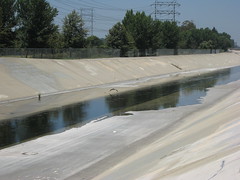
Some of the birds you may see here:
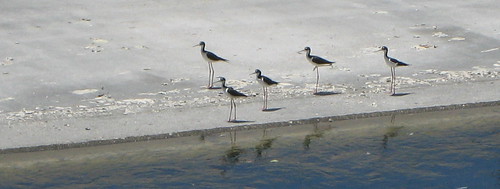 Black-necked stilts (Himantopus mexicanus)
Black-necked stilts (Himantopus mexicanus)
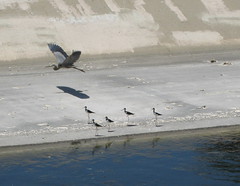
Great blue heron (Ardea herodias) (plus some more stilts)
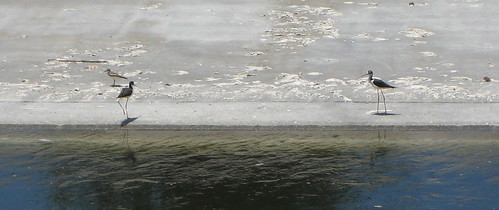
Small, but noisy killdeer (on the left, Charadrius vociferus), with yet more stilts.

A cliff swallow (Petrochelidon pyrrhonota
